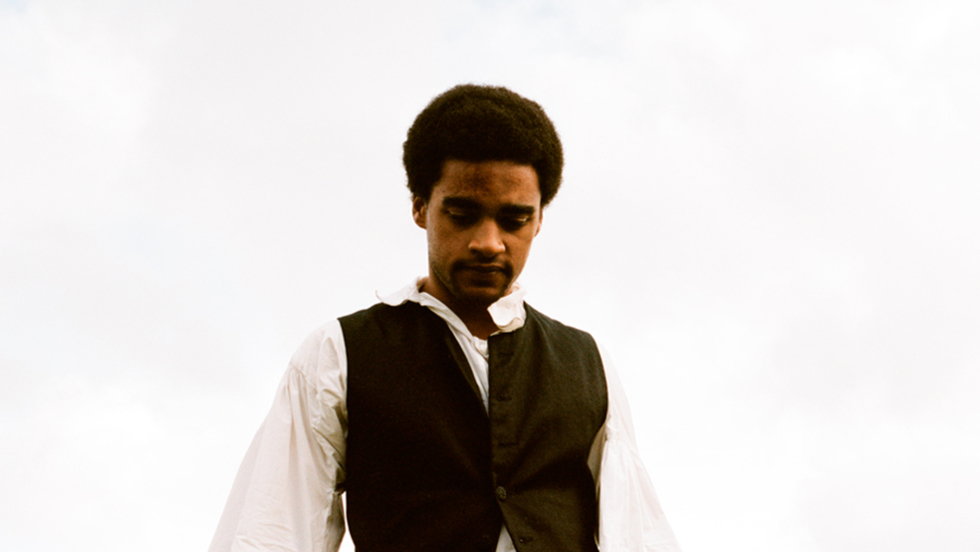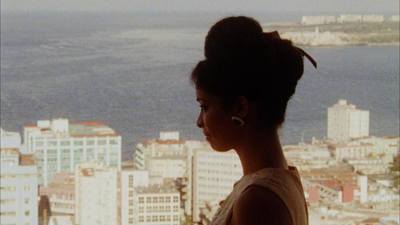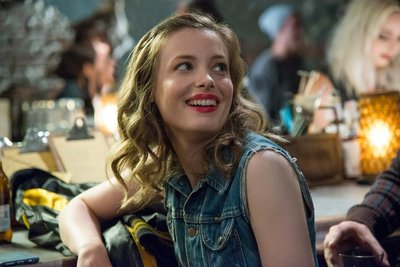
BY KAREN KEMMERLE |
Andrea Arnold was "Nearly Possessed" By Adapting "Wuthering Heights"
“Fish Tank” director Andrea Arnold has been to the moors and back with her adaptation of Emily Brontë’s famous novel about obsessive love. Expect the unexpected from this visionary and provocative director.

Experience Wuthering Heights like never before with Andrea Arnold’s visceral and poetic retelling of Emily Brontë’s Gothic classic. While the novel has gone through a long cycle of adaptations from television to film and back again, Arnold’s version is a welcome change from the traditional potboilers. Robbie Ryan’s gritty photography combines with Arnold’s instinctive grasp of Cathy and Heathcliff’s obsessive and destructive relationship to make for a refreshingly heartfelt film.
Instead of casting established actors in the vein of Laurence Olivier and Ralph Fiennes, Arnold chose James Howson for her adult Heathcliff, giving the unknown actor the double distinction of being the youngest actor and the first black man to ever play the complex anti-hero.
We were lucky enough to sit down with Andrea Arnold to discuss obsession, harsh shooting conditions and the challenges of working with first-time actors.

Tribeca: Your films are so fiercely original, which is why I was so excited to see your take on Wuthering Heights. Did you ever imagine yourself tackling Emily Brontë’s novel for the big screen? How did the project come together?
Andrea Arnold: No, no, no! When I agreed to do this, I thought it was a slightly spontaneous and very passionate decision. Not a very sensible decision at all. A friend of mine texted me and said, “Andrea, you said you’d never do an adaptation, and now you not only agree to do one but also pick one of the world’s most famous books. You are a stupid cow.” [laughs] And I thought, “He’s right. I am a stupid cow.” I knew it was a stupid thing to do. It was a crazy thing to do.
Once I decided I was going to do the adaptation though, I couldn’t put it down. Even now, after everything is said and done, I still think that. “God, you stupid woman!” I was nearly possessed by this project.
Tribeca: Well, possession is one of the novel’s biggest themes. I don’t think in any of the other Wuthering Heights adaptations I’ve seen that the obsessive love between Cathy and Heathcliff has ever been treated in quite this way. How have Brontë’s purists reacted to your adaptation?
Andrea Arnold: You know, I have no idea. I’m sure with horror [laughs].
Tribeca: One of the biggest changes you made in the book was making Heathcliff a person of color. However, if you’re carefully reading the novel, the clues are there. Did you always intend to take that approach with the character?
Andrea Arnold: I went through a bit of a process with it. When I looked at all the references to Heathcliff’s appearance in the book, it was clear to me he wasn’t white. He was definitely different. I don’t think Emily is very specific, but there is a line where Nelly describes him as a “lascar” and asks if his mother was an Indian princess or his father a Chinese emperor.
After a while I realized that he is different from the other characters on multiple levels, including very possibly his race. When Emily’s writing about Heathcliff, she’s really writing about herself or a part of herself, anyways. I started to feel that she felt different and, therefore, wanted to make difference an important theme in the novel.
It’s not such a weird idea. I wasn’t trying to be absolutely faithful to the book, but rather I wanted to capture the truth of his difference.

Tribeca: Wuthering Heights was so visually striking. The look of the film helped convey both the grim nature of the moors and their romantic aura. This is your fourth collaboration with cinematographer Robbie Ryan. Can you talk about your creative relationship?
Andrea Arnold: It’s really good. We get on really well. I complete adore him and we are great friends. As we go on, we have less to say to each other during the actual shooting because we already have quite a language together. There are certain things I do in every film that he knows. At the beginning of each film we do plan out the look we want. We’ll go on location and test different film stocks and different sizes and media. I’ll always have an idea of how I want it to be.
I don’t think we even tested on video. We always intended to shoot Wuthering Heights on film. We shot a 4:3 ratio and did some tests and shot directly on the screen. It just looked so gorgeous. It’s a very beautiful, respectful frame for a single person. That’s why I like it, I think. The actors are not dwarfed by the space around them. The frame focuses around them and gives them respect. There’s no filler.
Tribeca: Before you signed on, actors like Michael Fassbender, Ed Westwick and Natalie Portman were all rumored for roles in the Wuthering Heights remake, but you went with a cast of relative unknowns. How did you find James Howson, who played Heathcliff?
Andrea Arnold: When we had some screening for the financers, I joked that we should have Michael Fassbender and Natalie Portman do some dubbing and then we could say they were in it! [laughs] That way you could earn some more money back!
I always knew I wanted to cast an unknown in the role of Heathcliff because he’s such a raw character. He needed to have an underlying anger that was just present from the first time the audience sees him. I felt using someone who had never acted before would bring a different sort of feeling to the film. We had open casting calls, and James was there. He was looking for a job in an unemployment center in Leeds, and he saw one of the signs and came in. He had never done anything like that before. Half the cast had never acted before.
Tribeca: Right, I knew Kaya Schodelario, who played Cathy, from Skins. I thought she was really wonderful.
Andrea Arnold: I have actually never seen Skins, but when I met her I knew she would be perfect.
Tribeca: It was also refreshing to see age-appropriate actors playing the roles.
Andrea Arnold: Yes! I hated changing them. When I realized how important childhood was to the characters of Cathy and Heathcliff, I wanted them to be young for most of the film. At first, I thought I could get the 18-year-olds to play the younger versions of themselves because, ideally, you’d like to have the same people play all the way through. However, when I started meeting 18- and 19-year-olds, I could see that any part of their childhood was long gone. That sounds terrible, but it’s true. I knew I had to get two different people for the roles, which I knew would be difficult. It felt wrong to do, but I really had to capture their childhood.
Tribeca: There’s something about the fresh-faced look of a child that’s hard to duplicate.
Andrea Arnold: Right. Plus, they have things going on inside of them that they don’t even understand. When we’re older, we can see that. They don’t even know it’s there, which I find fascinating.

Tribeca: How do you approach working with new actors?
Andrea Arnold: Every single person requires something different, and once you get to know them, you can try things and see how they adapt. You just have to try and listen and respond to them in a way that allows them to work things out for themselves.
Tribeca: What were some of the challenges you faced shooting on location?
Andrea Arnold: It was the hardest thing I’ve ever done. I think the crew would agree with me as well. [laughs] The crew was so brilliant. Without them, it wouldn’t have been possible. They were so determined and good-spirited throughout. There was no place to sit down. There was mud everywhere. It was cold. We had to carry all the camera equipment because there were no vehicles allowed on the land.
Tribeca: How long was the shooting period?
Andrea Arnold: Eight weeks. It was originally going to be six, but with our child cast, there were lots of strict rules about how many hours they could shoot, etc. They became such a large part of the film that we just needed more time. It was so tough. It was like a vacation when we made it to the Grange and were able to shoot in that nice, warm house. The heights almost bloody destroyed us. We shot 5 days a week, so we partied hard on the last day. [laughs] We became very friendly with the local pub owners and people of the village.
Tribeca: Is there any one moment during the filming of Wuthering Heights that stands out in your memory?
Andrea Arnold: I have this one vivid memory of climbing the moor. We had to park the car then walk everything up hill. I was tired, and having to carry this extremely heavy camera box on my head, when my knees gave suddenly gave out. I was on my knees with this camera box and I just couldn’t get up. I just started crying and pulled my hat down over my face so that no one could see. Eventually, I got up and continued up the hill. When I made it to the top, I saw Rachel, our lovely camera assistant, standing by herself, crying, and holding a camera box. That’s how it was. We were all so psychically tired that it got to everyone. We just had to soldier on.
Tribeca: Wuthering Heights marked your fourth time at the Sundance Film Festival.
Andrea Arnold: That’s right! I can hardly believe it.
Tribeca: Does the Festival experience ever get any easier?
Andrea Arnold: I don’t know if I’d use the word “easier”... it [the festival circuit] is quite a life, you know. You get to travel to all these different places and see the world. You meet loads of nice people and get free gifts. Best of all, you are allowed to be indulgent and talk about your work with people who actually listen and care. It’s not exactly a hard life, is it? [laughs] I’m not going to knock it.
Wuthering Heights opens at Film Forum this Friday, October 5. For tickets, click here.
 Like Oscilloscope Laboratories on Facebook.
Like Oscilloscope Laboratories on Facebook.
 Follow Oscilloscope Laboratories on Twitter.
Follow Oscilloscope Laboratories on Twitter.
Watch the trailer:

